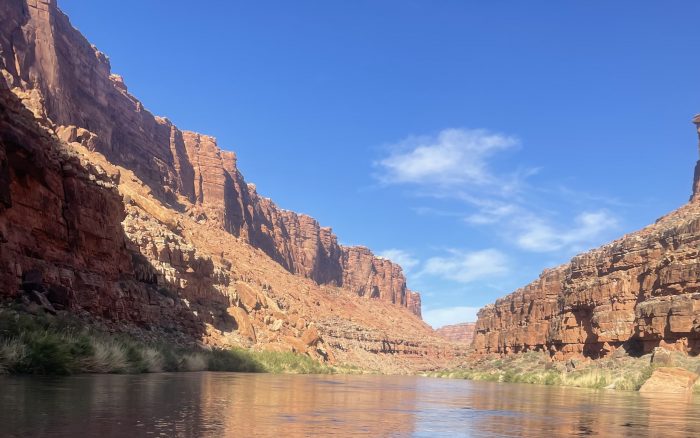Last week I returned from a rafting trip on the San Juan River in the Four Corners area of Utah. We floated through steep canyons on thick brown water for seven days, immersed in beauty. From the sunrise to sunset, the kaleidoscope of golden to deep pink-red cliffs guided us, their petroglyphs and pictograms offering mysterious stories of ancient peoples. The Bureau of Land Management and Glenwood Canyon National Recreation Area manage the land to the right side of the river; the left side is part of the Navajo Nation. Our two river guides came from historically contentious groups: Kevin, of Mormon descent, and Beni, Navajo.
There are many paradoxes in Utah. Like Napa County, the beauty of the Utah landscape is a troubled one, poisoned and controlled, in Utah’s case, by the mining, oil, and water industries. Utah native Terry Tempest Williams, author of Erosion: Essays of Undoing, quotes Representative Raul Grijalva (D) from Arizona. “The Republicans are pushing bills to divert protective funding, prioritize corporate land development, and sidestep science. These are blatant efforts to place corporate interest over species survival. (p. 50).” Williams calls this economic predation. Sound familiar?
My group was composed of my psychological colleagues. Each morning after coffee and breakfast, we gathered to report dreams, imagining together inner landscapes. “The outer wilderness mirrors our inner wilderness,” Tempest Williams writes. “ If we destroy what is outside us, we will destroy what is inside us. Something precious and original is lost. (p. 40)”
As we discussed the previous night’s dreams, we often experienced the grief of personal losses and our changing climate and future. Our world indeed is eroding. The fragile, fractured beauty of the San Juan canyons amplifies what is at risk. In some areas, the low vibrations of a helicopter can shake loose deep verticle fissures in the clifts, sending huge boulders tumbling. Acid rain from coal-burning has sped up erosion. The Southwest is in the worse megadrought in 1200 years. Climate change and the associated non-linear warming ensure that our future will not be like anything we have known. And scientists say this is only the beginning.
We talked of children and grandchildren and our future generations. How will we humans survive? For me, traveling through these canyons inhabited long ago by peoples who knew how to live in harsh conditions oddly brought some hope. Humans have done it before. But will our entitled population also be able to meet the challenges and make the sacrifices necessary in the coming years?
As paradox will have it, shared grief in our group brought openheartedness and care about each other in ways that surpassed self-interest. Can openheartedness save us? Beyond the polarization in our country that paralyzes action, can we amplify care that encompasses the disadvantaged, the environment, and the consideration of our future generations?
So I returned more motivated than ever to witness and address these same issues, Napa County style: drought, fire, water security, and carbon sequestration. When I opened my computer, the digital version of The Napa Valley Register appeared, reporting that the Board of Supervisors had just unanimously tentatively approved mitigation for cutting 14,000 mature trees on Walt Ranch by preserving 268 acres on the same ranch. This mitigation boggles the mind of anyone who thinks about it very much.
The 2300-acre Walt Ranch is a pristine area of our county and includes a watershed for the Milliken Reservoir, a water source for the City of Napa. Although the planning commission approved Walt Ranch in 2016, the project has been appealed to the Board of Supervisors (BOS) and the courts. Data supporting the Environmental Impact Report has been questioned. The latest appeal challenged only the mitigation of greenhouse gas emissions. BOS Chair Ryan Gregory stated, “This very narrow question we’re asked today, I still can’t find a way to say ‘no’ to it.” Earlier, Supervisor Diane Dillon implied this project would not be approved in 2022, given what we know now about water security and carbon. “We can’t undo what we did in 2016,” she said. “Things are so different now than they were then. We didn’t know what we didn’t know then.” (NVR)
Really? If you had listened to the scientists we brought before you, you would have known. Who are you looking out for, anyway? The county can’t afford to lose more carbon-rich environments like Walt Ranch if a climate catastrophe is to be averted or delayed. Why can’t you change your minds on something this dire?
“Utah is beautiful violence,” Tempest Williams writes. I include Napa County in this assessment. Economic predation is rampant. Our precious Ag Preserve and Ag Watershed lands are preyed upon by the wine and tourism industries and real estate developers. We need a Board of Supervisors who can take bold action to protect our watersheds, our environment, and the common good.
I remember the mornings on the San Juan River and the sharing of dreams, a ritual and ceremony that wove us together and opened our hearts to each other, to the birds singing around us, and the troubled cliffs carved by the river we navigated each day. “What is ceremony but a reminder of the power we can summon together?” Williams writes. “A sense of harmony is remembered and comes to us in the way of dreams that present themselves outside the normal parameters of time and space (p. 249-250).”
Our power in meeting the challenges of climate may rest in gathering with each other and caring for what happens to all: the environment and all inhabitants of Earth. Our silence, our denial, could be the death of us.
